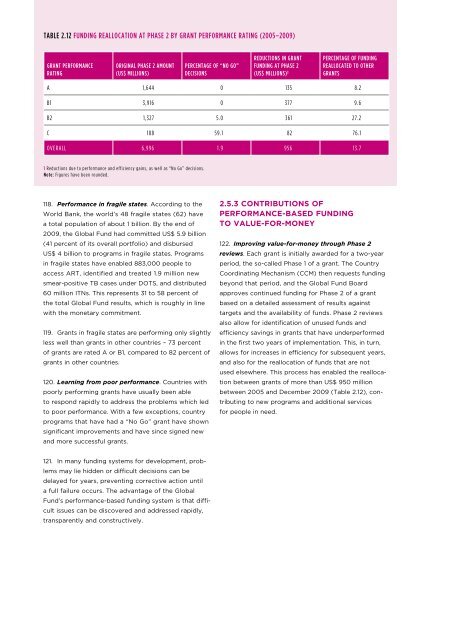Global Fund: Progress Report 2010 - unaids
Global Fund: Progress Report 2010 - unaids
Global Fund: Progress Report 2010 - unaids
Create successful ePaper yourself
Turn your PDF publications into a flip-book with our unique Google optimized e-Paper software.
TABLE 2.12 FUNDING REALLOCATION AT PHASE 2 BY GRANT PERFORMANCE RATING (2005–2009)<br />
GRANT PERFORMANCE<br />
RATING<br />
ORIGINAL PHASE 2 AMOUNT<br />
(US$ MILLIONS)<br />
PERCENTAGE OF “NO GO”<br />
DECISIONS<br />
REDUCTIONS IN GRANT<br />
FUNDING AT PHASE 2<br />
(US$ MILLIONS) 1<br />
PERCENTAGE OF FUNDING<br />
REALLOCATED TO OTHER<br />
GRANTS<br />
A 1,644 0 135 8.2<br />
B1 3,916 0 377 9.6<br />
B2 1,327 5.0 361 27.2<br />
C 108 59.1 82 76.1<br />
OVERALL 6,996 1.9 956 13.7<br />
1 Reductions due to performance and efficiency gains, as well as “No Go” decisions.<br />
Note: Figures have been rounded.<br />
118. Performance in fragile states. According to the<br />
World Bank, the world’s 48 fragile states (62) have<br />
a total population of about 1 billion. By the end of<br />
2009, the <strong>Global</strong> <strong>Fund</strong> had committed US$ 5.9 billion<br />
(41 percent of its overall portfolio) and disbursed<br />
US$ 4 billion to programs in fragile states. Programs<br />
in fragile states have enabled 883,000 people to<br />
access ART, identified and treated 1.9 million new<br />
smear-positive TB cases under DOTS, and distributed<br />
60 million ITNs. This represents 31 to 58 percent of<br />
the total <strong>Global</strong> <strong>Fund</strong> results, which is roughly in line<br />
with the monetary commitment.<br />
119. Grants in fragile states are performing only slightly<br />
less well than grants in other countries – 73 percent<br />
of grants are rated A or B1, compared to 82 percent of<br />
grants in other countries.<br />
120. Learning from poor performance. Countries with<br />
poorly performing grants have usually been able<br />
to respond rapidly to address the problems which led<br />
to poor performance. With a few exceptions, country<br />
programs that have had a “No Go” grant have shown<br />
significant improvements and have since signed new<br />
and more successful grants.<br />
2.5.3 CONTrIBUTIONS OF<br />
PErFOrmANCE-BASEd FUNdING<br />
TO VALUE-FOr-mONEY<br />
122. Improving value-for-money through Phase 2<br />
reviews. Each grant is initially awarded for a two-year<br />
period, the so-called Phase 1 of a grant. The Country<br />
Coordinating Mechanism (CCM) then requests funding<br />
beyond that period, and the <strong>Global</strong> <strong>Fund</strong> Board<br />
approves continued funding for Phase 2 of a grant<br />
based on a detailed assessment of results against<br />
targets and the availability of funds. Phase 2 reviews<br />
also allow for identification of unused funds and<br />
efficiency savings in grants that have underperformed<br />
in the first two years of implementation. This, in turn,<br />
allows for increases in efficiency for subsequent years,<br />
and also for the reallocation of funds that are not<br />
used elsewhere. This process has enabled the reallocation<br />
between grants of more than US$ 950 million<br />
between 2005 and December 2009 (Table 2.12), contributing<br />
to new programs and additional services<br />
for people in need.<br />
121. In many funding systems for development, problems<br />
may lie hidden or difficult decisions can be<br />
delayed for years, preventing corrective action until<br />
a full failure occurs. The advantage of the <strong>Global</strong><br />
<strong>Fund</strong>’s performance-based funding system is that difficult<br />
issues can be discovered and addressed rapidly,<br />
transparently and constructively.

















